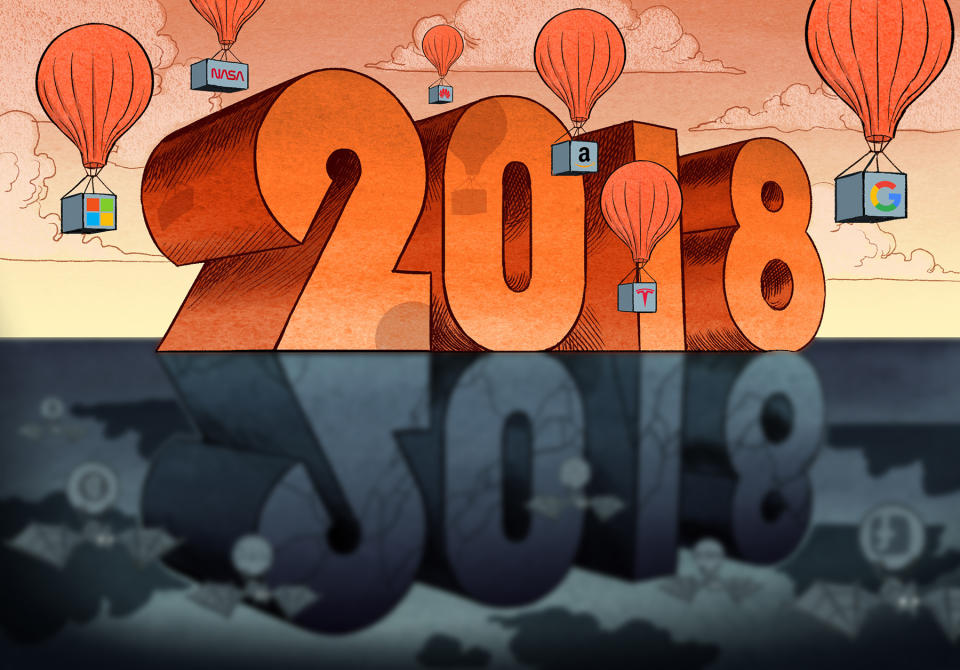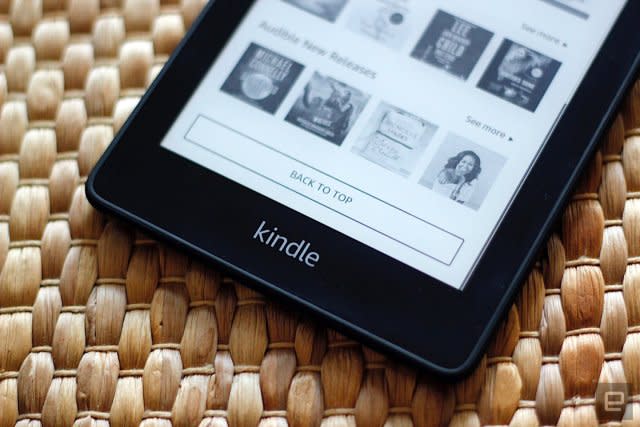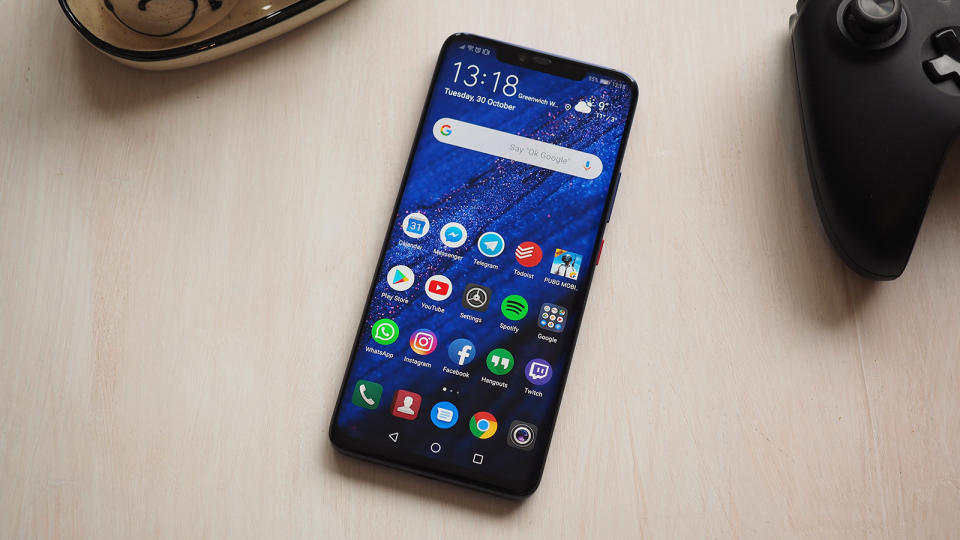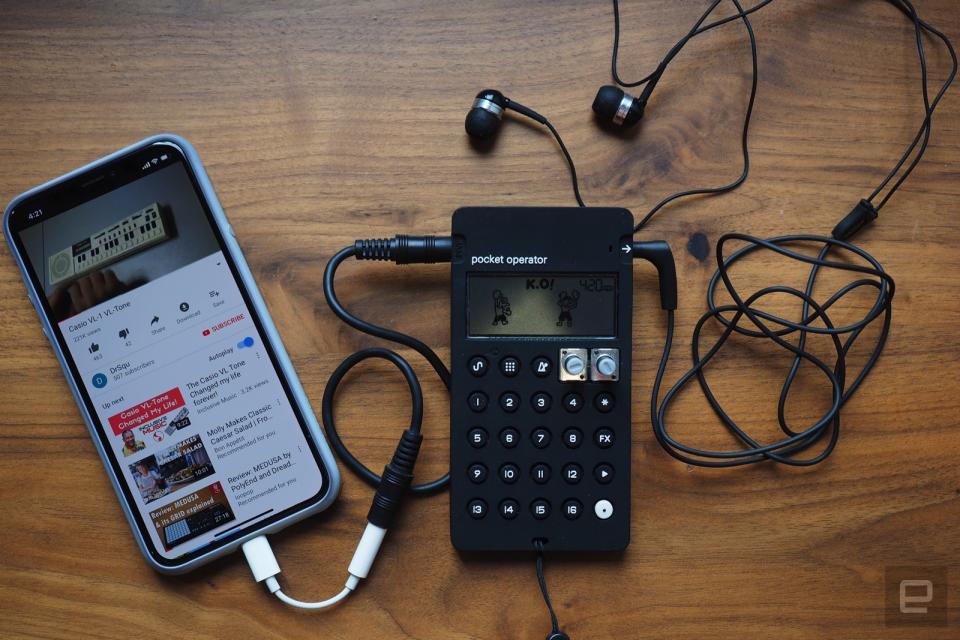The best gadgets of 2018
These are a few of our favorite (tech) things.
It's difficult to think of 2018 as a year with anything worth celebrating. But despite all the bad news the year dealt us, there were successes -- if you know where to look. In all corners of tech, we saw wins big and small. There were advances in obvious categories like laptops, smartphones and the connected home, but we also looked outside the mainstream for some of the more surprising gems. Think mini synthesizers for music nerds, retro emulators for nostalgic gamers and e-readers for modern book snobs. Humanity also collectively triumphed, as our space exploration programs broke new frontiers this year and we began to confront the increasingly real question: Should we all just move to Mars?
2018 may have been a stinker of a year, but many of its developments laid the foundation for improvements next year. We're just two weeks away from what is hopefully a much better 12 months, and the Engadget team took some time to commemorate our favorite gadgets and trends in tech.
Apple Watch Series 4

Dana Wollman
Editor-in-Chief
For the Apple Watch, it seems that four times is a charm. After years of marketing the device in different, sometimes contradictory ways -- it's a running watch! It can replace your smartphone sometimes! -- Apple has come up with a more compelling reason for people to buy this thing: It might actually promote better health. The new Apple Watch Series 4 stands out for being the first consumer-grade device that can perform an electrocardiogram (ECG), a test used to diagnose a potentially dangerous heart condition called atrial fibrillation. Though the FDA is careful to note that this feature shouldn't be used to replace a doctor's visit, that the device received FDA clearance at all marks an important milestone for smartwatches. In addition to that, the watch detects low heart rates and ushers in a new fall-detection mode -- a handy feature for the elderly (and family members who can't always be nearby). All of this adds up to a more serious, more broadly useful health tracking device.
And those are just the wellness features. The Series 4 is otherwise a well-rounded, all-purpose device, with a sleek, waterproof design, bright screen, improved performance and battery life and a fun Walkie Talkie feature. Like previous generations, the Series 4 also offers accurate step tracking, built-in LTE and an ever-growing selection of watchfaces, some of them useful, and some just very pretty. In a year where Google redesigned Wear OS and Qualcomm launched a new made-for-wearables CPU, it's saying something that Apple still delivered the best smartwatch.

Amazon Kindle Paperwhite

James Trew
Managing Editor
You like to read... heck, you're doing it right now. I like to read, too, and as an anti book-snob, that makes me a fan of Amazon's Kindle line. The internet's bookstore makes various models, but the owner of the Kindle crown isn't the premium Oasis -- it's the Paperwhite. And this year, it has even more jewels in it thanks to new features and that Goldilocks price point.
The Paperwhite already had most of the features you'd want: Weeks-long battery life, a touchscreen (sorry, button-lovers) and an illuminated, crisp display. The 2018 model just ramped up the goodness with waterproofing and Bluetooth (for Audible support) among other minor improvements. Given that the 2017 Paperwhite was already one of our highest scoring gadgets, it's obvious why the latest model maintains its position at the top.
Of course, there are other e-readers: Nook and Kobo for example. But as Amazon started with (real) books, it's no surprise that the retail behemoth has dominated the e-book market too. I just wish the company had chosen another name... every time I read the word Paperwhite, I groan a little inside. Other than that, the Paperwhite (ugh) was without doubt one of the easiest products to review all year.

Google Home Hub

Nicole Lee
Senior Editor
Even though Amazon launched the Echo Show and the Echo Spot last year, 2018 was when the smart display category really came into its own. A big reason for that is Google. Not only did the company partner with manufacturers like Lenovo and JBL to deliver a line of Google Smart Displays, it also introduced its very own take on the concept with the Home Hub. And as unlikely as it may seem, this tiny, simple piece of hardware is our favorite smart display yet, and one of the best gadgets this year.
Lenovo's smart display got us hooked on the idea of Google Assistant on a screen. Being able to watch YouTube videos, follow step-by-step cooking directions and get images alongside search results are already compelling reasons to get a Google-powered connected display.
But Google's Home Hub brought a new design element to the category that suddenly made the smart display not just a clever piece of tech, but something you'd actually want in your house. Unlike other smart displays like the Echo Show, the Home Hub was designed to blend in with the rest of your decor. Its small footprint, minimal design and soft fabric finish make it look attractive enough to earn a spot on your mantle or shelf. Most notably, the Home Hub doesn't have a camera, which helps alleviate privacy concerns, making it ideal for intimate spaces like the bedroom.
Huawei Mate 20 Pro

Jamie Rigg
Reviews Editor
This year's fall flagship season was stacked with heavy hitters like Apple's latest iPhones, Samsung's Galaxy Note 9, and a pair of fresh Pixels from Google. Across the board, they showcased some of the best smartphone tech around, from cameras to advancements in AI. And yet, Huawei's Mate 20 Pro offers something more. Something a little bit better.
The Mate 20 Pro is lovingly designed, and particularly gorgeous in the multicolor Twilight finish that's quickly become a hallmark of the Huawei brand. It's got a large, vivid display that occupies almost the entire face of the device, save for the now-ubiquitous notch. It's as powerful as phones get, and boasts an abnormally long battery life.
Arguably its headline feature is an unparalleled camera experience -- an area Huawei has excelled in recently. Three intermingling lenses create a quality and versatility that isn't found on other smartphones. With the camera's AI smarts backing you up, it's pretty hard to take bad photos.
The real reason the Mate 20 Pro climbed to the top of the pile this year, though, is because of the little things. Features like the in-screen fingerprint reader, reliable face unlocking and the ability to wirelessly charge other devices from the Mate 20 Pro. Huawei took every premium convenience it had and crammed them into one handset.
It's not perfect. The Mate 20 Pro is the first phone to support Huawei's unwelcome propriety NM Card for expanding storage. Its screen coating scuffs easily and the EMUI Android skin is looking a little dated. It's not really available in the US either, at least in terms of official carrier support, which will suck for some. But the fact remains that in a year of excellent smartphones, the Mate 20 Pro still pushed the boundaries, even if by just a little.

Alexa everywhere

Cherlynn Low
Reviews Editor
We were all a little caught off-guard when Amazon said it had 70 things to unveil at its Alexa event in September. But as the announcements dropped one after another, something became very clear: Amazon is bent on stuffing Alexa inside anything it can imagine. From speakers and displays to TVs, cars and even microwaves and wall clocks, nothing is safe from Alexa's control.
Some of these integrations might not seem to make sense -- why do you have to ask Alexa to heat up your food if you're already at the oven and can press a button? But the funny thing is, Amazon's strategy is surprisingly effective. I enjoyed asking Alexa to get the AmazonBasics microwave to reheat lunch for me, and honestly wouldn't mind if the assistant were in my kitchen, my bedroom and my closet.
The more opportunities Amazon can create for people to interact with Alexa and the cheaper it can do so, the more likely the company will win the digital assistant war and dominate our lives. In 2019, we'll see all the more places Alexa will go, and one day, it may even end up in our head.

Laptops

Cherlynn Low
Reviews Editor
For years, it seemed like every generation of notebooks was just delivering the same boring incremental performance upgrades and calling it a day. In 2017, the most interesting feature was HP's built-in privacy screens that hid your sensitive data from nosy onlookers, and even that was an update from years past. This year, however, we saw more intriguing developments. Companies from ASUS and HP to Qualcomm and Microsoft showed off intriguing new products and ideas, injecting a fresh shot of excitement and making me care about covering laptops again.
Though Qualcomm and Microsoft announced the Windows on Snapdragon program years ago, it was in 2018 that we finally got to test the first such PCs. The chip maker continued to up the ante by pushing out not just one but two CPUs designed for PCs -- the Snapdragon 850 and Snapdragon 8cx. Though Windows on ARM still needs a ton of work, at least Qualcomm is giving Intel some incentive to make its own connected laptops. This competition means only good things for consumers wanting a notebook that's always online while also powerful and long-lasting.
Then ASUS showed off a dual-screen laptop and launched a Zenbook with a compelling touchscreen trackpad. Lenovo also dropped a new hybrid with an e-ink screen in place of a keyboard while Huawei hid a pop-up webcam under a Function key. HP straight up made a laptop out of leather, because who says a notebook has to be metal or plastic? We're on the precipice of a new generation of laptops; they're going to look different, behave different and will ultimately become much more versatile than before. 2019 is going to be fire.
Teenage Engineering PO-33 KO

Terrence O'Brien
Managing Editor
Music nerd darlings Teenage Engineering launched three products in 2018, including a new flagship portable synth in the OP-Z. But it was one of the affordable Pocket Operators that easily stole the show. The PO-33 KO is an insanely fun pocket-sized sampler with 40 seconds of memory and 16 effects. It even has a built-in mic and speaker. It's not without its flaws (fiddly knobs, terrible customer support), but there's simply nothing else like it.
You can actually build fairly complex arrangements and songs, even with its limited polyphony -- making it a real game changer for the beat maker always on the go. Any similarly capable sampler and sequencer is many times the size and price of the KO. And while some of them could qualify as "portable," they're definitely not pocketable.
Sure, you can do a lot of the same things on a phone. In fact Garage Band is far more capable from a pure features perspective. But it's also far more complicated. Plus, it's impossible to overstate the value of having a purpose-built device with physical controls and no social media to distract you.

Noise-canceling headphones

Devindra Hardawar
Senior Editor
It used to be that you needed to trade off sound quality if you wanted a pair of noise-canceling headphones. At least, that was the case when Bose was your only option. But in just a few years, Sony managed to trounce Bose with its 1000XM cans, balancing great quality with top-of-the-line noise canceling. The 1000XM3 ($350) are its best version yet, with a dedicated chip that blocks out sound four times better than before, while also giving its DAC more headroom to pump out quality tunes.
Sony also fixed plenty of minor issues with past models: There's now more space for large ears, and less of a gap between the armbands and your head. They're so comfortable it's easy to forget you're wearing them. As a bonus, the battery life is even better, lasting up to 30 hours between charges. And did we mention they sound fantastic? There's even support for the high-quality LDAC codec on newer Android phones. We're hard pressed to find much wrong with the 1000XM3, aside from Sony's annoying touch controls. If you can afford them, they're among the best noise-canceling headphones you can buy today.
This year, we also saw plenty more companies try their hand at noise canceling: Microsoft's Surface Headphones are a stylish option that uses two dials to control volume and sound dampening. And if you prefer earbuds, Libratone managed to fit the technology into the Track+, which are also water- and sweat-resistant for exercising. While you're still paying a premium for noise canceling with most devices, we also saw cheaper options hit the market, like Anker's $100 Soundcore wireless headphones.
In general, it seems like more companies are taking audio gear seriously this year. Even Dolby, which typically stays on the software side of things, decided to release its first pair of headphones this year: the $600 Dimension. They're insanely expensive, sure, but they make a statement. Some people are willing to do whatever it takes for the best audio experience possible.

Spacecraft / InSight Lander

Mallory Locklear
Contributing Writer
Just a few weeks ago, NASA's InSight lander arrived on Mars, completing a more than six-month-long journey. And because Mars is a such a difficult place to land -- an endeavor at which many have failed -- a successful landing on the planet is a win in and of itself. InSight will be the first probe to study the interior of Mars, but even in its short time on the planet, it has already given us other first-time experiences, like hearing the sound of Martian wind. It's a groundbreaking craft, both literally and figuratively, and it's just getting started.
But InSight is just one of a number of successes humanity has had this year when it comes to space. We've also placed a probe in orbit around an asteroid, launched a spacecraft to study the sun, started another hunt for exoplanets and sent a lander to study the far side of the moon. We achieved major milestones, too: Opportunity surpassed 5,000 days on Mars and Voyager 2 entered interstellar space. It may be weird to catch feelings for spacecraft, but it was also bittersweet when we had to say goodbye to Kepler, which was retired after an almost 10-year hunt for exoplanets, and Dawn, which began its asteroid belt mission in 2011.
It wasn't just about study and discovery, either. 2018, more than any other year, marked a new era in spaceflight. SpaceX made reusing equipment routine and with the successful launch of its Falcon Heavy, it delivered the world's most powerful operational rocket. Further, both SpaceX and Boeing are getting closer and closer to providing NASA with its first Commercial Crew flights.
What an exciting year it's been for space study and spaceflight. And since many of this year's successes are only just beginning their missions -- such as the Parker Solar Probe, TESS and InSight -- 2019 is already shaping up to be a great year for discovery, curiosity and learning.
Google Pixel 3

Mat Smith
Bureau Chief, UK
When Cherlynn reviewed this year's Pixel phones, she said the hardware took a backseat to software. While it pains me to admit it, she's not wrong. The best example is that while the Pixel 3 packs just a single rear-facing camera, it's capable of fantastic images that best dual- and tri-camera layouts found on other phones. Google knows what it's doing: Top Shot isn't going to rescue bad photos but it does offer extra frames to pick from when friends have blinked or a moving subject is slightly blurred, while Night Sight (now that it's finally here) performs imaging miracles in a phone that isn't going to peep out of my jean pockets. The Pixel 3 is also one of few options for flagship specs at a sensible size.
At its core, the Pixel 3 camera is stunningly effortless. You don't have to deep-dive the camera menus to make your pictures sing, Google's imaging smarts do it for you. I recently went on a weeklong vacation to Belgium and Holland. Instead of a camera, I just made sure I had my Pixel 3 and the photos came out incredibly well, with great contrast, colors and next to no blur. I could even let my family take the selfies, because it's pretty much foolproof. Just last week, after lengthy testing, we called it the best smartphone camera of the year. Talk about vindication.
But it's not just the camera. There are plenty of hardware touches and improvements I like: the matte finish on the back, the brightly colored power button and the fastest wireless charging on a smartphone ... if you have the right (Google-made) wireless charger.
So why isn't it objectively the best phone? It's not perfect. The Pixel 3 and 3 XL are substantially more expensive than before, and Google has struggled with a litany of bugs and issues since launch. Maybe the Pixel 3 isn't the best phone of the year, objectively, but Google has proven that it can consistently make devices that can sell themselves.

Retro emulation done right

Aaron Souppouris
Features Editor
In a year where we've reviewed trainwrecks like the C64 Mini and Sony's PlayStation Classic, it's worth noting there were still some positives for emulation in 2018.
First and foremost, Analogue continued its fantastic NT series with the Super NT, a dream of an SNES micro console that sports near-flawless emulation of any cartridge you can throw at it. It's built solidly, outputs at various resolutions, and includes advanced buffer options, interlacing and other video modes. Unlike Analogue's older consoles, which ran close to $500, the Super NT is priced at a more-affordable $189.
Away from the high-profile launches, there's now an abundance of cheap, "good enough" emulation options. The Raspberry Pi and other similarly tiny DIY computers have lowered the bar of entry to emulation, letting you consolidate your retro game collections in a tiny Linux box for just a few dollars. And portable consoles such as the Pi GRRL Zero, the Game Boy Zero and the RetroStone essentially do the same thing, but with a low-power chip and a battery for gaming on the go.
None of these Linux boxes offer anything close to perfect emulation. The PlayStation Classic, which is just a locked-down system running the PCSX ReARMed emulator, is proof of that. But when you're DIY-ing it, these machines are flexible and very easy to get started with. The communities developing both the emulation cores and the front-ends like RetroArch are constantly working to improve them, and you can usually work around any issue you might come across. And hey, not needing to spend hundreds on an OSSC or Framemeister to make your old console play nice with a modern TV can only be a good thing.
Here's hoping next year brings more of the good, and less of the bad. We're already excited for Analogue's take on the Genesis next March, and, despite Nintendo's protests to the contrary, we won't be at all surprised to see an N64 Classic drop in time for the 2019 holiday season.




































